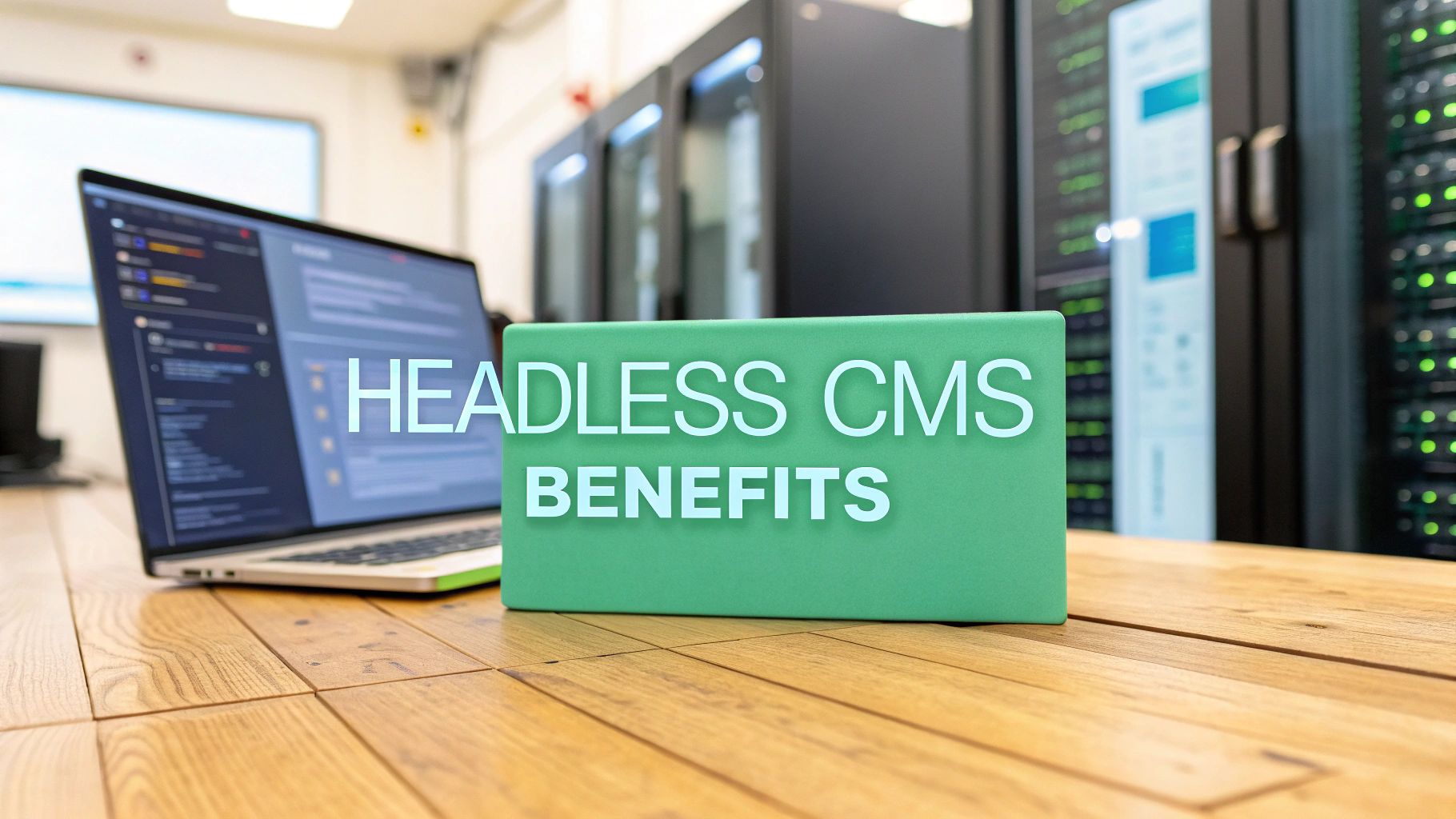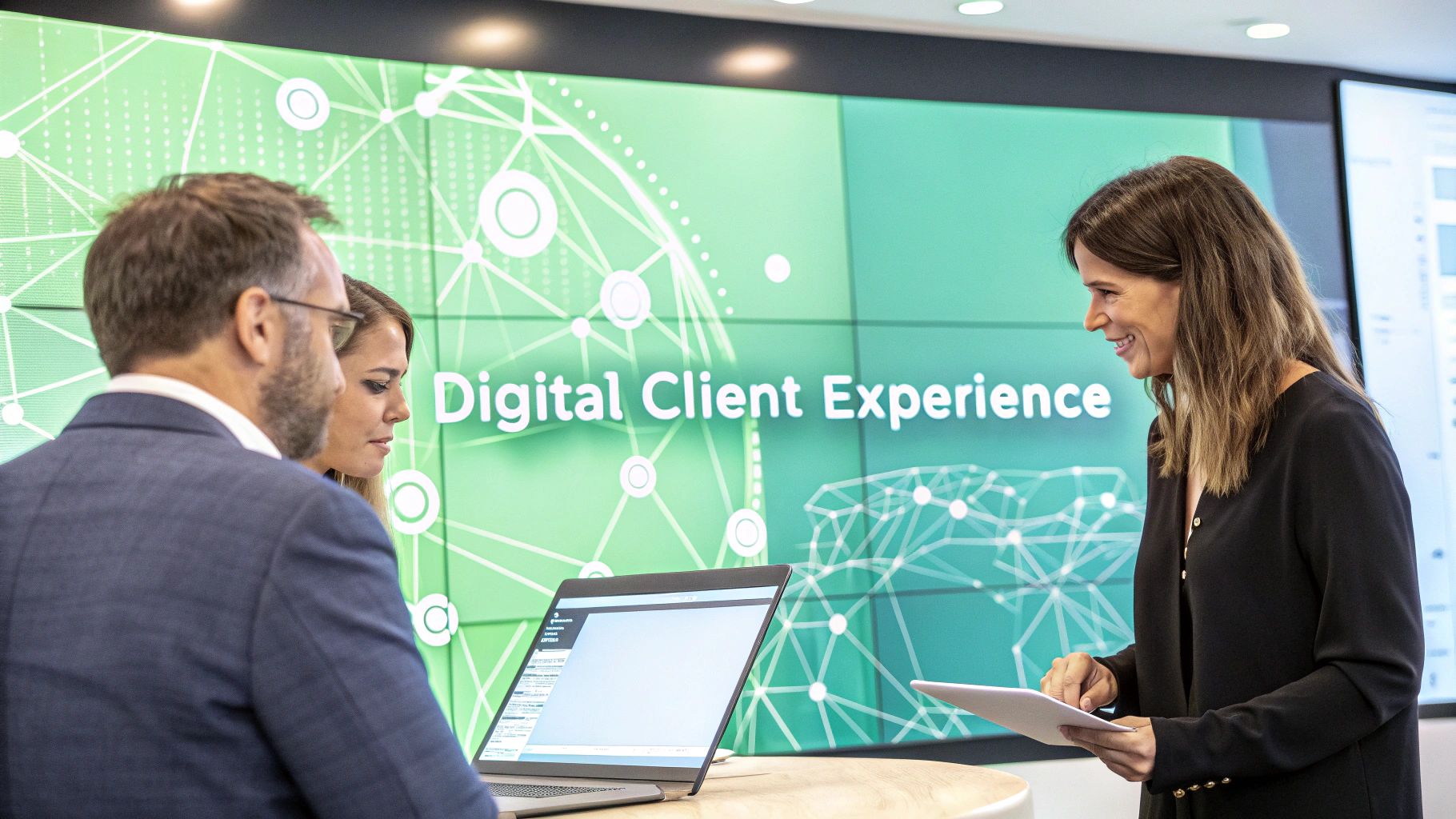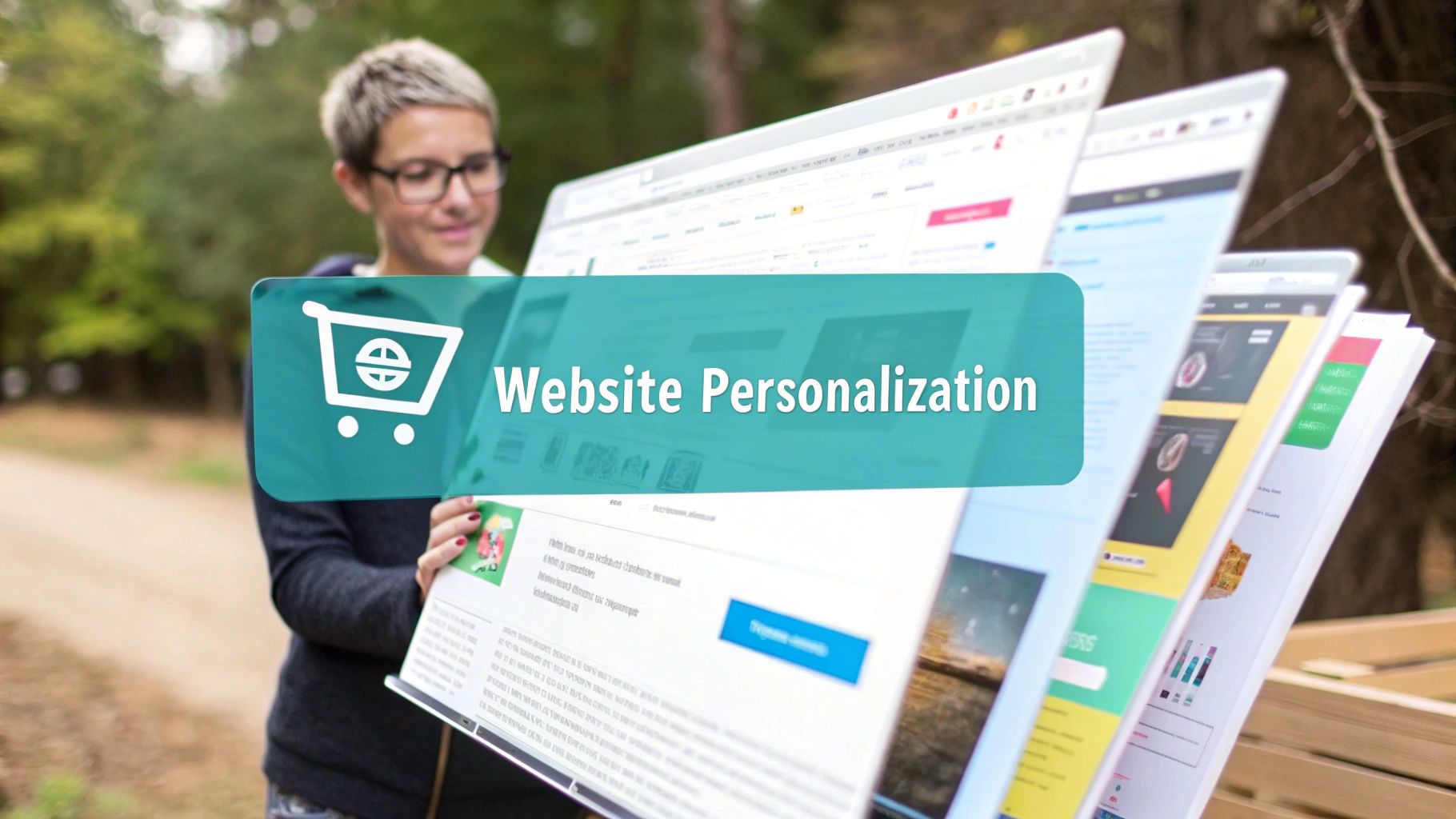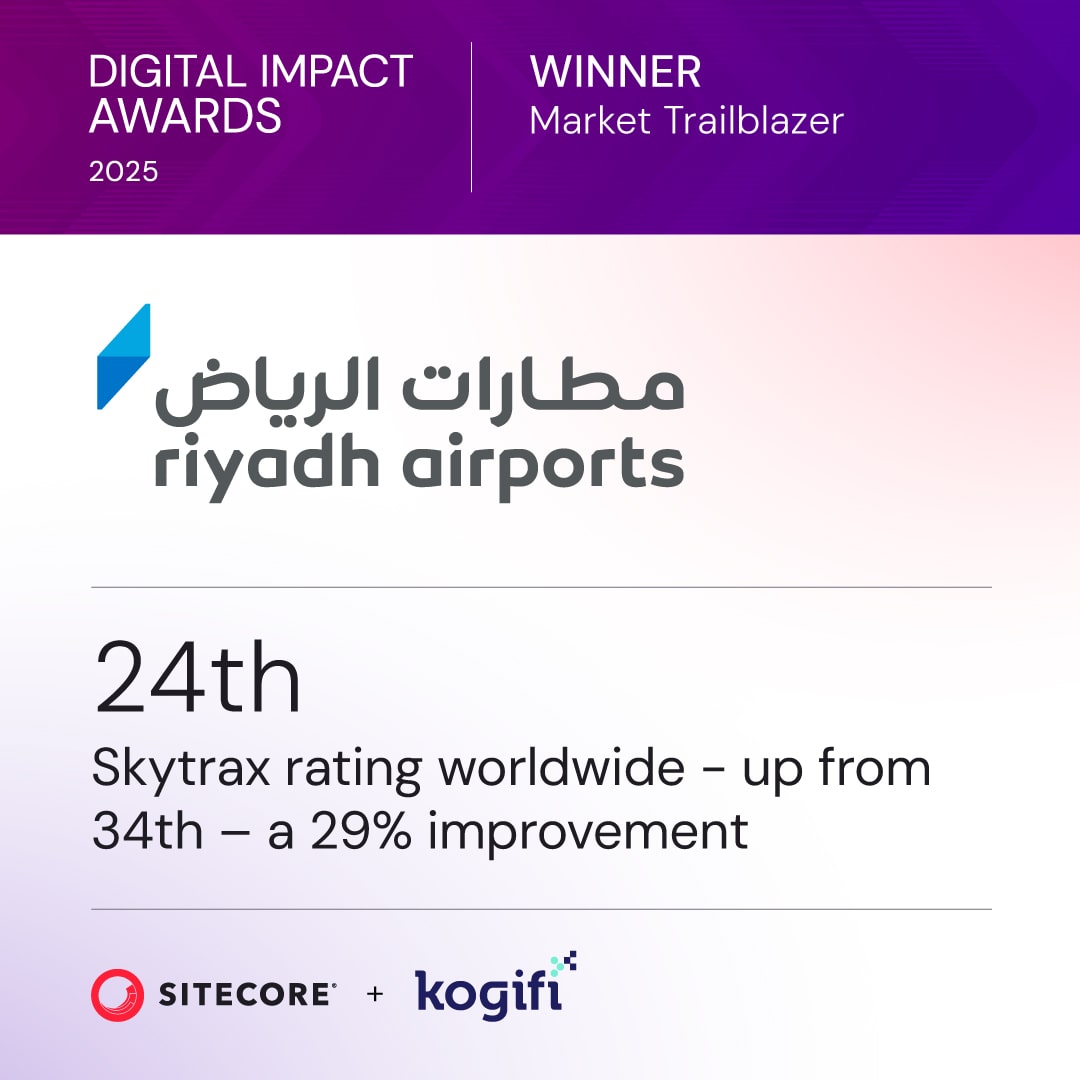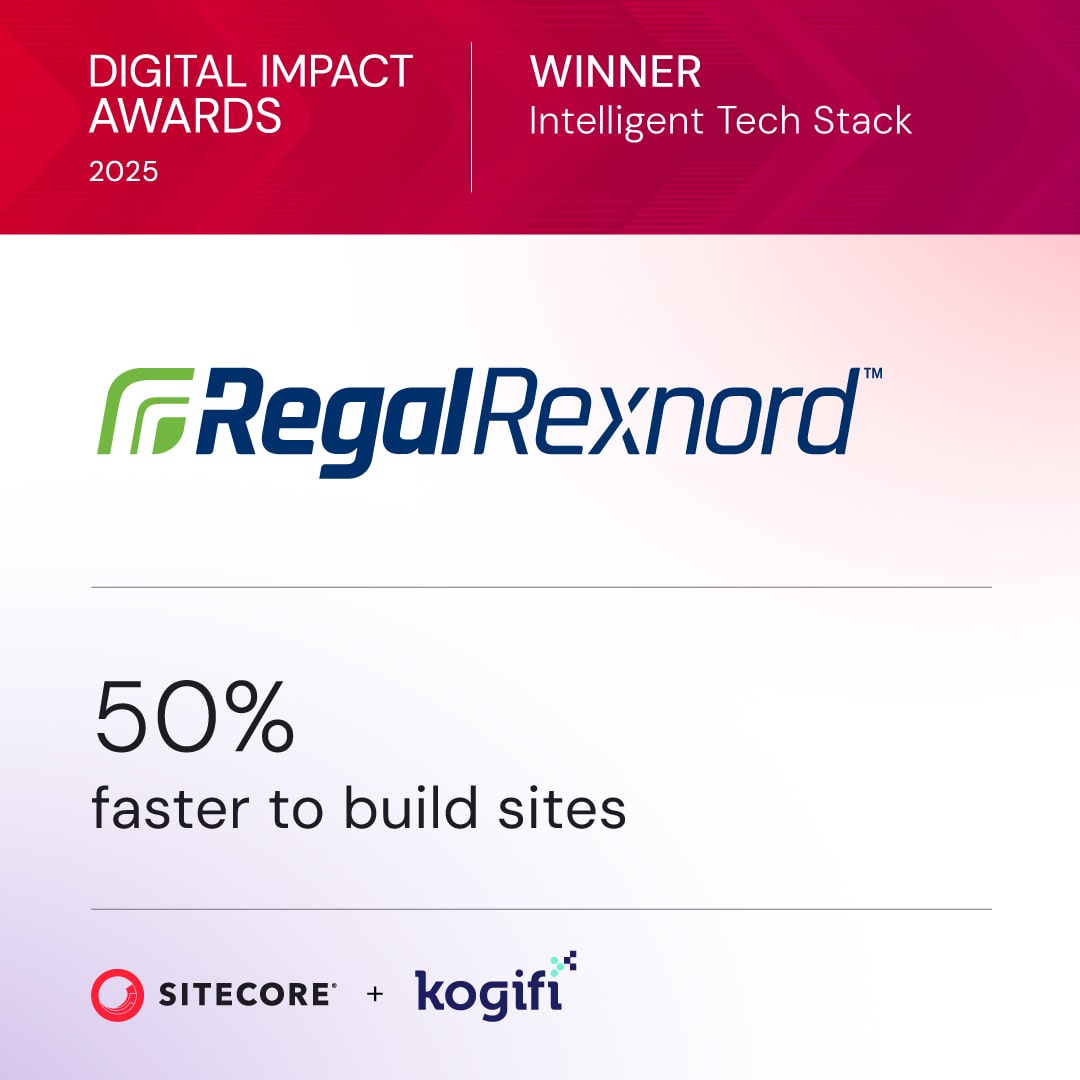In a hyper-connected environment, delivering consistent, high-performance experiences across a growing array of channels is no longer optional, it's essential. Traditional CMS platforms, with their tightly coupled content and presentation layers, often create bottlenecks, limit technological innovation, and struggle to keep pace with audience demands. This is where a headless architecture revolutionizes the entire approach to digital content management.
By decoupling the 'head' (the frontend presentation layer) from the 'body' (the backend content repository), a headless CMS provides unparalleled flexibility and power. For enterprise teams using robust Digital Experience Platforms (DXP) like Sitecore or collaborative hubs like SharePoint, this shift isn't just a technical upgrade; it's a strategic move towards future-proof agility. This architectural freedom allows developers to use modern frameworks while marketers can manage content centrally and deploy it anywhere, from websites and mobile apps to IoT devices and digital signage.
This article details the ten most impactful benefits of headless CMS, providing actionable insights for digital marketers, e-commerce managers, and development teams. We will explore how this modern architecture empowers you to build faster, more secure, and highly personalized digital experiences that can scale with your organization's ambitions.
1. Omnichannel Content Delivery
One of the most significant benefits of a headless CMS is its inherent ability to power omnichannel content delivery. By decoupling the content management backend (the "body") from the presentation layer (the "head"), a headless architecture allows you to create content once and distribute it anywhere. This means a single piece of content, like a product description or a promotional campaign, can be seamlessly delivered to a website, a mobile app, an in-store kiosk, or even an augmented reality (AR) experience. This approach ensures brand consistency and a unified message across every customer touchpoint.

For enterprise-level organizations, this capability is a cornerstone of modern digital experience platforms (DXPs). Platforms like Sitecore excel in this area with products such as XM Cloud and Content Hub, which are specifically designed for creating atomic, reusable content. This content is then exposed through robust APIs, like GraphQL, allowing any frontend application to consume it. This flexibility is crucial for building a cohesive and effective omnichannel customer experience.
Practical Implementation and Tips
To leverage this benefit, focus on a content-first strategy. For instance, a global retailer can use Sitecore to manage product information that feeds its e-commerce site, native mobile apps, and in-store digital signage from one central repository.
- Design a Flexible Content Model: In Sitecore, create structured content models that are channel-agnostic. Define fields that are universally applicable, avoiding presentation-specific elements.
- Utilize Webhooks for Real-Time Updates: Configure Sitecore webhooks to instantly push content changes to all connected channels, ensuring data consistency without manual intervention.
- Plan for Versioning: Leverage Sitecore's built-in content versioning and workflow capabilities from the project's start to manage content variations and approvals across different platforms.
2. Improved Performance and Loading Speed
A key advantage of a headless CMS is the significant boost it provides to website performance and loading speed. By separating the backend content repository from the frontend presentation layer, developers are free to build highly optimized, lightweight applications. Content is delivered swiftly via APIs, which unlocks powerful performance-enhancing techniques like static site generation (SSG), advanced caching, and seamless Content Delivery Network (CDN) integration. This results in faster page loads, better Core Web Vitals, and a superior user experience that search engines reward.

This performance gain is a major reason why many enterprises adopt headless architectures. For instance, platforms like Sitecore XM Cloud are built to leverage these benefits, integrating directly with modern frontend frameworks like Next.js and Vercel's high-performance hosting. This combination allows for pre-rendering pages at build time, serving them from a global edge network, and dramatically reducing server response times. The result is an incredibly fast experience for users worldwide, which directly impacts engagement and conversion rates, making it one of the most compelling benefits of headless CMS for e-commerce and marketing sites.
Practical Implementation and Tips
To maximize performance, development teams should focus on optimizing the entire content delivery pipeline. For example, a global brand using Sitecore can pre-build its most-visited marketing pages as static assets and deploy them to an edge network for near-instantaneous delivery.
- Implement Static Site Generation (SSG): Use Sitecore's headless SDKs with frameworks like Next.js or Nuxt.js to generate static HTML pages for content that doesn't change frequently.
- Utilize a Global CDN: Integrate your frontend application with a CDN like Cloudflare or Sitecore Experience Edge to cache content geographically closer to your users, reducing latency.
- Optimize Media Assets: Leverage Sitecore Content Hub's digital asset management (DAM) capabilities to automatically optimize and transform images for different devices and channels before they are delivered via the API. For more insights on this topic, you can explore detailed strategies on how to optimize website performance.
3. Complete Frontend Flexibility and Technology Independence
A key advantage that distinguishes headless architecture is the complete freedom it grants development teams over the frontend technology stack. By separating the content repository from the presentation layer, organizations are no longer locked into proprietary, monolithic systems. Developers can select the best-fit frameworks and languages, like React, Vue.js, or Angular, to build highly optimized and custom user experiences. This independence ensures that your technology choices serve your business goals, not the other way around.
This flexibility is a core tenet of modern enterprise platforms like Sitecore, which champions a composable DXP approach. Using Sitecore XM Cloud, developers can consume content via its Edge APIs and build with any frontend technology they prefer, from popular JavaScript frameworks to native mobile SDKs. This approach allows enterprises to future-proof their digital properties, as they can update or entirely replace the frontend without disrupting the backend content operations. Exploring the differences between these models highlights why this is one of the crucial benefits of headless CMS vs. traditional CMS.
Practical Implementation and Tips
To maximize the benefits of this flexibility, a strong API strategy is essential. For example, a company using Sitecore as its content hub can simultaneously power a React-based corporate website, an Angular-powered customer portal, and a native iOS application.
- Establish Clear API Contracts: Define a clear and stable contract between the Sitecore backend and various frontend applications to ensure seamless communication and prevent breaking changes.
- Leverage GraphQL for Efficiency: Use Sitecore's GraphQL endpoint to allow frontend developers to request only the specific data they need, reducing payload sizes and improving application performance.
- Document API Endpoints Thoroughly: Maintain comprehensive and up-to-date documentation for all API endpoints, making it easier for frontend teams to onboard and build new experiences quickly.
4. Faster Time-to-Market and Agile Development
A key benefit of headless CMS architecture is its ability to dramatically accelerate development cycles and time-to-market. By separating the content repository from the frontend presentation layer, development and content teams can work in parallel. Frontend developers are free to build new user experiences using modern frameworks like React or Vue.js without being constrained by backend release schedules, while content authors can create and manage content independently. This decoupling eliminates traditional bottlenecks and fosters a more agile workflow.
For large enterprises, this agility translates into a significant competitive advantage. For example, a global brand using a headless platform like Sitecore XM Cloud can rapidly launch a new microsite for a marketing campaign. The marketing team can finalize content in Sitecore while a separate frontend agency builds the user interface. Because the two streams are disconnected, the project can be completed in weeks instead of months, allowing the organization to respond swiftly to market trends.
Practical Implementation and Tips
To fully capitalize on this accelerated workflow, a well-defined agile process is essential. Organizations can leverage the API-first nature of headless systems to streamline development and deployment, enabling faster and more frequent releases.
- Implement CI/CD Pipelines: Set up automated continuous integration and continuous deployment (CI/CD) pipelines. This ensures that as soon as frontend code is committed, it's automatically tested and deployed, drastically reducing manual intervention.
- Establish Clear API Contracts: Define a clear API contract between the backend (Sitecore) and the frontend application at the beginning of the project. This ensures both teams understand the data structure and can work without waiting on each other.
- Use Feature Flags for Rollouts: Employ feature flags to gradually release new functionalities to users. This allows you to test features in a production environment with a small audience before a full-scale launch, minimizing risk.
- Maintain Comprehensive Documentation: Keep detailed and up-to-date documentation for your APIs. This is crucial for quickly onboarding new developers and ensuring development teams can work efficiently without constant communication overhead.
5. Enhanced Security and Compliance
A significant benefit of a headless CMS is its inherently stronger security posture. By decoupling the content management backend from the public-facing presentation layers, the core content repository and administrative functions are not directly exposed to the internet. This separation dramatically reduces the attack surface, making it much more difficult for malicious actors to access the CMS database or exploit vulnerabilities common in monolithic platforms. This architecture inherently protects sensitive data and business-critical content.
For enterprises in regulated industries like finance or healthcare, this is a critical advantage. Sitecore's composable architecture, particularly when using XM Cloud, isolates the content authoring environment from the publicly accessible delivery endpoints. This design simplifies achieving compliance with standards such as GDPR, HIPAA, and PCI DSS. Sensitive data is managed in a secured backend, while only approved, non-sensitive content is delivered via read-only APIs, minimizing compliance risks at the edge.
Practical Implementation and Tips
To maximize security, enterprises should leverage the architectural separation. For example, a financial services firm can use a headless Sitecore instance to manage marketing content, ensuring that its secure customer-facing portal and the content management system have no direct connection, thereby satisfying stringent PCI DSS requirements.
- Implement Robust API Security: Secure your Sitecore Edge and GraphQL endpoints with strong authentication protocols like OAuth 2.0. Enforce rate limiting to prevent denial-of-service attacks.
- Enforce Strict Access Controls: Utilize Sitecore's granular, role-based security model to ensure editors and administrators only have access to the content and features necessary for their roles.
- Conduct Regular Audits: Routinely review Sitecore's audit logs and user permissions. This helps detect unauthorized activity early and ensures compliance with internal security policies and external regulations.
6. Superior Scalability and Reduced Infrastructure Costs
One of the most powerful benefits of a headless CMS is its capacity for superior scalability while simultaneously reducing infrastructure costs. Because the content management backend is separate from the presentation layer, each component can be scaled independently. This means your content repository can handle millions of API requests without impacting the performance of your various frontends, from websites to mobile apps. This architectural freedom allows for highly efficient resource allocation.
For global enterprises, this translates into significant operational advantages. Platforms like Sitecore XM Cloud, built on a composable, cloud-native architecture, excel in this environment. The backend content services autoscale based on demand, while the frontend, often deployed on modern hosting platforms like Vercel or Netlify, can be globally distributed via a Content Delivery Network (CDN). This approach not only ensures high availability and fast load times but also minimizes the need for over-provisioned, monolithic server infrastructure, leading to substantial cost savings.
Practical Implementation and Tips
To maximize scalability and cost-efficiency, focus on a cloud-native and API-first strategy. For example, a large e-commerce business using Sitecore can serve its product catalog to millions of users globally by leveraging XM Cloud's elastic infrastructure and a geo-distributed CDN, ensuring peak performance during high-traffic events like Black Friday without manual intervention.
- Implement a Multi-Layer Caching Strategy: Use caching at the CDN edge, within the application, and at the API gateway level to reduce direct hits to the CMS and database, drastically improving response times.
- Leverage Auto-Scaling Policies: In a platform like Sitecore XM Cloud, rely on built-in auto-scaling capabilities or configure custom policies based on metrics like API request volume or CPU usage to dynamically adjust resources.
- Optimize API Queries: Use GraphQL to design precise API queries that fetch only the necessary data, which reduces payload size and minimizes backend processing load for each request.
7. Better Collaboration Between Teams
Another of the key benefits of a headless CMS is its capacity to foster better collaboration by decoupling team workflows. Because content creation and frontend development are separated, teams can work in parallel without bottlenecks. Marketers and content editors can manage, update, and publish content independently, while developers are free to build and iterate on user experiences using their preferred frameworks. This clear separation of concerns dramatically improves workflow efficiency and reduces cross-team friction.
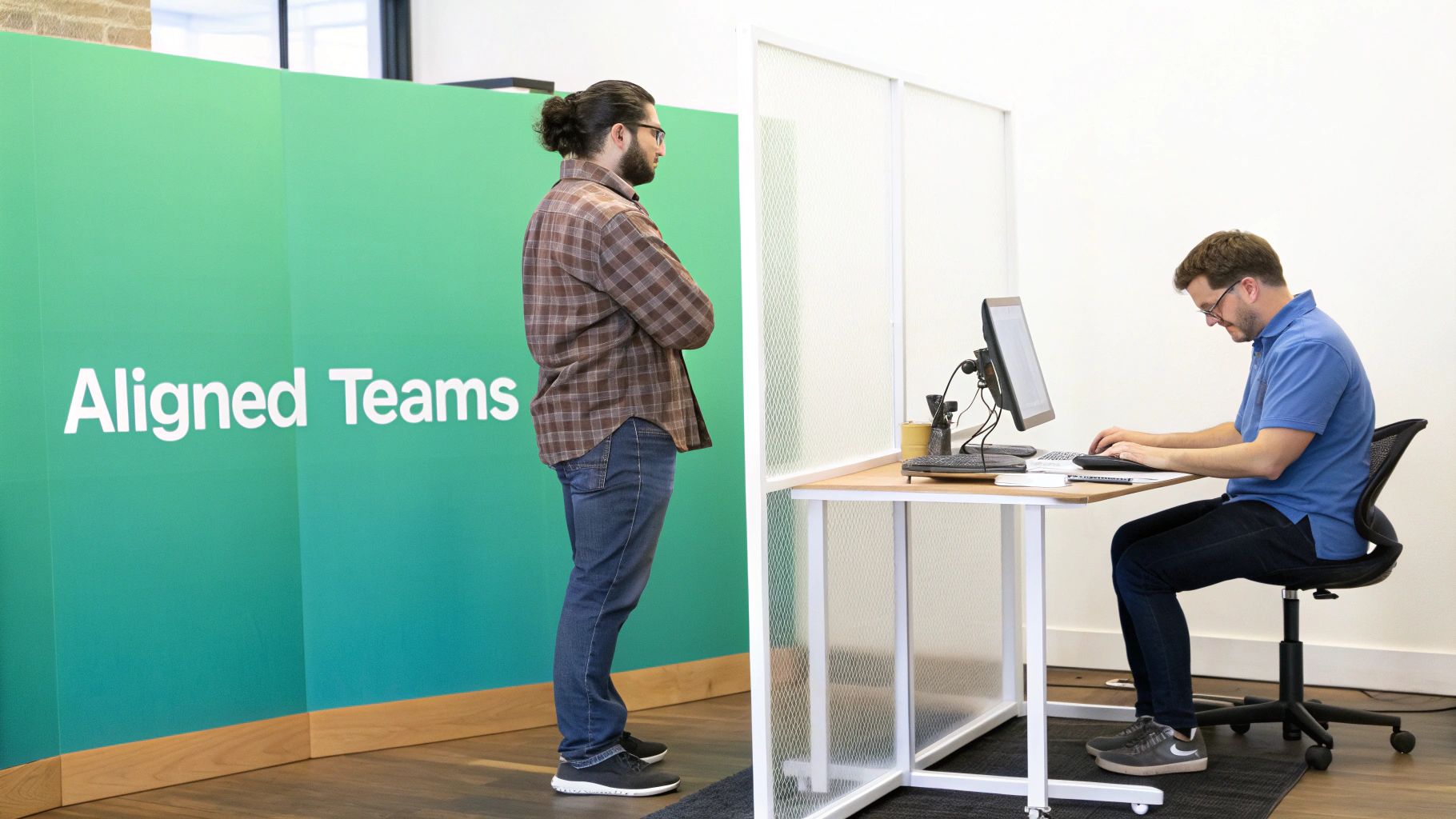
This parallel workflow model is a game-changer for large enterprises seeking to increase their content velocity. For instance, teams using Sitecore XM Cloud can empower their editorial staff to create and schedule campaigns without needing a developer to deploy code changes. The content team works within a user-friendly editing interface to manage structured content, while developers consume that content via APIs to build engaging digital frontends. This enables organizations to accelerate time-to-market for new content and features.
Practical Implementation and Tips
To maximize collaborative efficiency, focus on establishing clear processes and governance from the outset. A well-defined content model is the foundation for seamless teamwork between content creators and developers.
- Establish Clear Governance: Use Sitecore's roles and permissions to define clear boundaries. Ensure content editors have access only to the fields and workflows relevant to their tasks.
- Provide Comprehensive Training: Equip non-technical teams with the skills to use the CMS effectively. Offer training sessions on Sitecore's content modeling and editing interfaces to build confidence and autonomy.
- Implement Approval Workflows: Configure Sitecore's built-in approval workflows to formalize the content review process, ensuring quality and compliance before anything goes live. This is essential for maintaining brand standards across all channels.
8. Future-Proof and Adaptable Architecture
One of the most strategic benefits of a headless CMS is its inherently future-proof and adaptable architecture. Because the content backend is decoupled from any specific frontend, organizations are free to innovate and adopt new technologies without being locked into a monolithic system. This API-first approach means you can easily integrate emerging channels like voice assistants, IoT devices, or even metaverse experiences, ensuring your digital strategy remains relevant and competitive for years to come. Your content foundation becomes a stable, long-term asset, while your customer-facing experiences can evolve at the rapid pace of technology.
For forward-thinking enterprises, this adaptability is critical. A platform like Sitecore XM Cloud is designed with this principle in mind, offering a composable architecture that allows businesses to add or swap frontend technologies and third-party services as needed. This flexibility prevents the costly and disruptive need to replatform every few years. Instead of a complete overhaul, you can incrementally update your digital ecosystem, preserving your core content investment while delivering cutting-edge experiences.
Practical Implementation and Tips
To maximize the longevity of your headless architecture, focus on building a system designed for evolution. For example, a retailer using Sitecore can feed product content not only to a website but also to an AR app for virtual try-ons or a voice-activated shopping skill for Amazon Alexa, all without re-architecting the core CMS.
- Design Evolving Content Models: Build your content models in Sitecore with flexibility in mind. Avoid fields tied to a specific layout, and instead, focus on structured, semantic data that can be repurposed for future, unknown channels.
- Use Semantic API Versioning: Implement a clear versioning strategy for your APIs. This allows you to introduce new features or changes for new frontends without breaking existing applications.
- Plan for Extensibility: From the start, leverage webhooks and plan for custom integrations. This ensures your headless CMS can easily connect with future marketing automation, AI, or analytics tools as they become available.
9. Easier Integration with Third-Party Tools and Services
A key advantage of a headless CMS is its API-first design, which dramatically simplifies integration with other best-of-breed tools and services. Instead of being locked into a monolithic suite, a headless architecture allows you to assemble a composable digital experience platform (DXP) by connecting specialized services. This means marketing automation, analytics, e-commerce, and CRM systems can communicate seamlessly without complex custom development or fragile data synchronization scripts.
This composable approach is central to modern enterprise strategies. A business using Sitecore as its content repository can effortlessly integrate with Salesforce for customer data, an e-commerce platform like Sitecore OrderCloud for transactions, and Sitecore Personalize to tailor user experiences. This flexibility empowers organizations to build and evolve their tech stack with the best tools for each specific job, fostering innovation and agility.
Practical Implementation and Tips
To maximize the integration benefits of a headless CMS, a strategic approach to your technology ecosystem is essential. For instance, an enterprise can use Sitecore's headless capabilities to feed content into a SharePoint-based intranet, while simultaneously pushing product updates to a B2B commerce portal.
- Map Your Tech Stack: Before implementation, create a comprehensive map of your entire digital ecosystem, identifying all data sources and integration points.
- Leverage Middleware: For complex integrations between systems like Sitecore and SAP, consider using middleware to manage data transformation, orchestration, and error handling.
- Establish Data Governance: Define clear rules for how data flows between integrated systems. Document who owns the data, how it is updated, and the single source of truth for each data entity to maintain consistency.
10. Personalization and Customer Experience Optimization
A key advantage of headless CMS architecture is its ability to facilitate sophisticated, real-time personalization. By separating content from presentation, organizations can deliver tailored experiences based on user data such as behavior, location, or past interactions. This enables dynamic content rendering and A/B testing at a granular level, moving beyond one-size-fits-all content to highly relevant, individualized customer journeys.

This capability is a cornerstone of modern digital strategy, allowing brands to optimize conversion rates and enhance customer loyalty. In an enterprise context, platforms like Sitecore Personalize are specifically designed to leverage this decoupling. By integrating with a Customer Data Platform (CDP), Sitecore can trigger content variations across any channel, from a website to a mobile app, based on a unified customer profile. This moves beyond simple content swaps to creating truly adaptive digital experiences, a crucial element in achieving AI-driven personalization at scale.
Practical Implementation and Tips
To effectively use a headless CMS for personalization, marketing and development teams must collaborate on data strategy and implementation. For instance, a retailer can use Sitecore Personalize to show different hero banners to new versus returning visitors or to dynamically adjust product recommendations based on real-time browsing behavior.
- Integrate with a CDP: Connect your headless CMS to a robust CDP like Sitecore's to build comprehensive, 360-degree customer profiles for accurate targeting.
- Establish a Testing Framework: Implement a structured A/B and multivariate testing program to validate your personalization hypotheses and measure their impact on key metrics like engagement and conversion.
- Ensure Data Privacy Compliance: Prioritize responsible first-party data collection and management, ensuring full compliance with regulations like GDPR and CCPA while building user trust.
Headless CMS — 10 Benefits Compared
Making the Leap to Headless with an Expert Partner
The journey through the core benefits of headless CMS reveals a clear, compelling picture: the future of digital content management is decoupled, agile, and API-first. From delivering consistent omnichannel experiences and achieving unparalleled site performance to empowering developers with complete frontend freedom, the advantages are transformative. For organizations committed to robust platforms like Sitecore and SharePoint, this architectural evolution isn't just an option; it's the key to unlocking the full potential of their digital investment and staying ahead in a competitive landscape.
Recapping the critical takeaways, we've seen how a headless approach directly addresses the most pressing challenges faced by modern marketing, e-commerce, and enterprise teams. The ability to push content to any channel, from websites and mobile apps to IoT devices and digital kiosks, is no longer a "nice-to-have." It is the foundation of a modern customer experience strategy. The performance gains, enhanced security, and superior scalability offered by decoupling the frontend from the backend provide a tangible competitive edge, reducing infrastructure costs and mitigating risks.
From Theory to Tangible ROI
Mastering these concepts moves your organization from a traditional, monolithic mindset to a dynamic, composable one. This shift empowers your teams to work more efficiently, with developers free to use the best tools for the job and marketers able to manage content independently. The result is a faster time-to-market for new initiatives, a more resilient and future-proof digital architecture, and the agility needed to integrate new technologies as they emerge.
The benefits of a headless CMS are not just technical; they are strategic business advantages that drive growth, improve customer satisfaction, and maximize your return on investment. The transition allows you to fully leverage the powerful personalization capabilities of platforms like Sitecore Personalize or integrate seamlessly with your existing SharePoint workflows, creating a truly unified and intelligent digital ecosystem.
Actionable Next Steps: Charting Your Course
Embracing this transformation requires more than just new software; it requires a new strategy and specialized expertise. Navigating the complexities of content modeling, API design, and modern frontend frameworks demands a partner with a deep understanding of both the technology and your business goals.
For enterprises built on Sitecore and SharePoint, this journey is best undertaken with a guide who knows the terrain intimately. A specialized partner can help you:
- Audit your existing content architecture to identify opportunities and plan a phased migration.
- Develop a robust content modeling strategy that ensures your content is structured, reusable, and channel-agnostic.
- Select the right frontend frameworks and integration patterns to meet your specific performance and experience requirements.
- Train your teams on the new workflows and best practices to ensure long-term success and adoption.
Adopting a headless CMS is a decisive step toward building a more powerful, flexible, and resilient digital future. It is an investment in adaptability, ensuring your organization can meet customer expectations not just today, but for years to come. By moving forward with a clear strategy and the right expert guidance, you can confidently harness the full power of this architectural paradigm.
Are you ready to unlock the full potential of your Sitecore or SharePoint investment with a headless architecture? The team of certified experts at Kogifi specializes in designing and implementing high-performance, composable solutions that drive business results. Contact Kogifi today to schedule a consultation and begin your journey toward a faster, more flexible digital future.

















